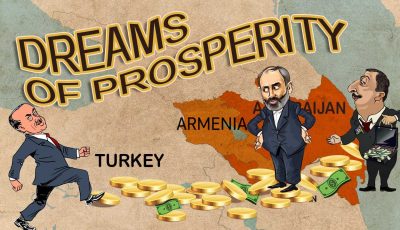Video: Second Karabakh War Reshapes Strategic Transport Corridors in South Caucasus

The Second Nagorno-Karabakh War not only led to a shift of the military political balance of power in the South Caucasus, but the agreements reached to put an end to it would potentially greatly reshape transport links, and thus freight and passenger flows in the region. The deployment of Russian peacekeepers to Azerbaijan, the growth of Turkish-Azerbaijani cooperation and the decline of the project of the Armenian Nagorno-Karabakh Republic are reactivating several strategic directions that have been inactive for almost 30 years and regional players are now publicly declaring plans regarding the creation of new economic corridors.
For the first time since independence, Armenia will have to conduct work on boundary settlement, including the creation of official border crossings. Until recently, the Azerbaijani-Armenian border in the Karabakh region did not in fact exist and the Armenian government used the area as a kind of buffer zone. This cannot remain unchanged since Azerbaijan has gained districts bordering Armenia. Just recently, the vague reaction of the Armenian government to Azerbaijani troops entering the Sotk gold mine located just on the border between both states demonstrates the scale of the problem.
At the same time, the Lachin corridor, which links Armenia with what is left of the Nagorno-Karabakh Republic, remains under the control of Russian troops which provide security to civilians moving along it. However, the situation here is also complex. Since Azerbaijani forces captured Shusha, the road linking Stepanakert with Lachin partially passes through the zone of control of the Azerbaijani military. In future, as the reached agreements say, there is a plan for an alternative route that would by-pass Shusha.
The situation with the southern transport corridor between Azerbaijan and its Nakhichevan Autonomous Republic is also curious. Under the agreed deal, it is supposed to be unlocked under the control of the Border Service of the Russian Federal Security Service. There is not only an automobile road, but also a railway passes along the border in the south. This corridor was abandoned as a result of the First Nagorno-Karabkah War. Gradually, Armenia dismantled its parts of the railway, but Azerbaijan kept them up to Horadiz in the east, and within the Nakhichevan enclave.
In their turn, Iran, taking advantage of the years of anarchy in this “no-man’s” buffer territory, quietly built the Khudaferin hydroelectric power station and flooded about 15 km of the dismantled railway. The original landscape was seriously changed. This makes the restoration of the railway much more difficult and a part of it, after the flooding, will likely have to be created in a rock tunnel. By the way the location of the Khudaferin hydroelectric power station by itself also changed the possible route of any potential railway. In these conditions, the restoration of the railway in the area would require significant investment and work and on top of this would require a significant amount of time.
Turkey, a traditional Azerbaijani ally, would be happy to take advantage of the unblocking of transport links. Ankara has a long ago announced plan of construction of a railway to Nakhichevan and this project is being reactivated. Turkey has a relatively weak railway network in its east and even the capacity of the corridor to Iran is limited by the ferry through the Van lake. Thus, the creation of a railway link to Nakhichevan would boost not only Azerbaijani-Turkish economic ties and guarantee the ground link between Azerbaijan and Turkey, but would also increase the economic potential of the east of Turkey.
Apologists for the current Armenian government speculate that the defeat in the war and the loss of Karabakh, which is now de facto under the control of the Russians, in fact plays into the hands of the Armenians. Now, they will allegedly be able to de-escalate their relations with Azerbaijan, enter joint economic projects with it and even trade with Iran through Nakhichevan. These versions are from the same group of fairy tales that came up with a Euro-Atlantic rescue rangers team that would be compelled to protect Armenian forces in Karabakh in the event of an Azerbaijani attack because modern Armenia has a very ‘democratic’ and ‘European-oriented’ government. As might have been expected, this did not happen. Dreams about some mysterious European integration, also widely fueled by international funds and the group of traitors sitting in Armenian top offices are also hardly likely to be turned into reality. Nonetheless, if Armenia keeps its current course, it will have the opportunity to sell off the remaining vestiges of its territories and sovereignty and to turn itself into a kind of outpost for globalists and NATO in the Southern Caucasus. The only difficulty would be that together with this Armenia would likely have to surrender its south to please one well-known NATO member state led by the Neo-Ottoman-styled President.
In theory, the unblocking of transport corridors should allow to intensify economic life in the South Caucasus and to create new opportunities for the restoration of the region after years of conflict. However, in practice, the implementation of these projects would require much time and would face significant difficulties growing from the remaining tensions among the sides involved.
*
Note to readers: please click the share buttons above or below. Forward this article to your email lists. Crosspost on your blog site, internet forums. etc.
SUPPORT SOUTHFRONT:
PayPal: [email protected], http://southfront.org/donate/ or via: https://www.patreon.com/southfront

